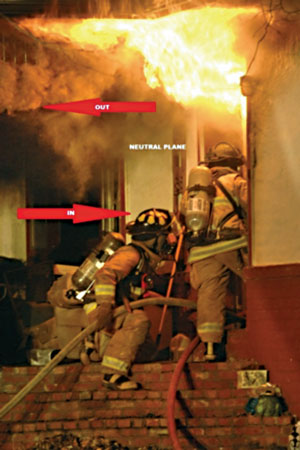A closer look at a bidirectional flow path
Author’s note: The writer has been in the fire service for 15 years. He has a master’s degree in public administration from the University of Colorado, Denver; a bachelor’s degree in exercise science-corporate wellness from Winona State University in Minnesota; and an associate degree in fire science from Aims Community College in Colorado.
I am writing in reference to “Flow Paths and Fire Behavior” by Jonathan Monaghan (The Engine Company, October 2015). Although I am fully in support of progressive research and data collected by Underwriters Laboratories (UL), the National Institute of Standards and Technology (NIST), and the Bureau of Alcohol, Tobacco, Firearms, and Explosives (ATF) as well as independent organizations such as Kill the Flashover, it is imperative that we portray the correct information to those new and old in the fire service.
 |
| (1) Photo courtesy of the Bloomington (IL) Fire Department. |
The information on flow paths and studies that coincide with it in the article are significant to modern-day tactics and fireground operations. This clearly improves our situational awareness, firefighter mind-set, and tactical decision making under stress. However, the photo used to demonstrate “bidirectional” flow path is inconclusive, as we do not know if this is a second-floor fire with a patio or if the fire door is open on the first floor. In this instance, this would actually be determined to be a unidirectional flow path. In addition, the photo does not clearly show the “neutral plane” or level of “thermal buoyancy” as would be defined by science. The photo in this letter is an example of a bidirectional flow path as well as the neutral plane. Although there are many other images available, this one seems to capture it the best and shows the dangers of placing a firefighter in those circumstances.
Another point to note (which can create debate) is Monaghan’s use of the statement “cool the smoke.” Through science and the research conducted by the ATF and NIST, this is not a valid statement. Although the explanation is well-written, it does not define the true process taking place. NIST refers to this tactic in Module 4 of the Governor’s Island series as “cooling the environment.” Smoke is fuel, but fire (energy) is consuming the environment first as it progresses down a hallway or throughout a room. This in essence creates the convection currents and radiation that we know can hurt, injure, or kill firefighters. Therefore, it is essential that we cool the environment we are entering when we cannot overcome and change the flow path with which we are faced.
The great thing about this article and the findings from NIST, UL, and ATF is that they clearly show there is further scientific (chemical and physical) study needed within the fire service to improve the overall safety of the modern-day firefighter.
Rene Macias
Lieutenant, Station 1
Loveland (CO) Fire Rescue Authority
Fire Engineering Archives

